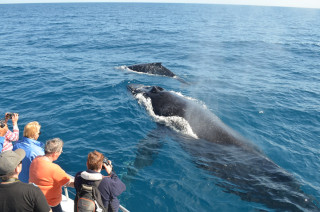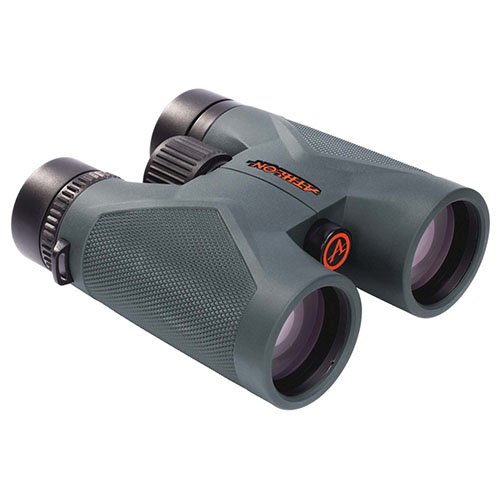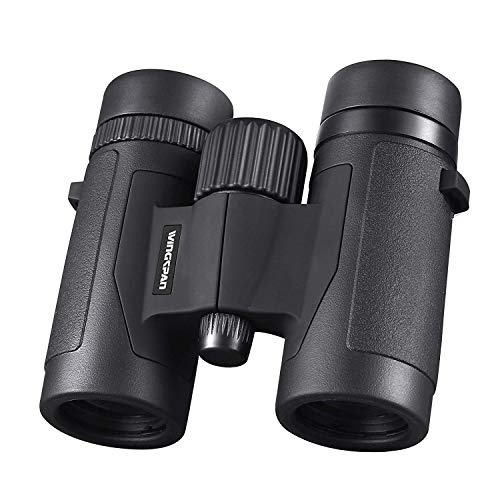6 Best Binoculars for Whale Watching in 2025 – Reviews & Buying Guide
Last Updated on

Whales got smart when they were being hunted aggressively many years ago, and they learned to stay away from boats and people. If you are one of the many people who love to watch them play, you’ll want a good pair of binoculars to bring them closer to you so you can see them in detail.
There’s a wide variety of binoculars available today, and it may be puzzling to know where to start looking for that perfect pair. We have reviewed many and compiled a list of six that we think you may enjoy. Of course, we want you to get the full picture of each, so we’ve listed some of the pros and cons of each one for you to read.

A Quick Look at Our Favorites in 2025
| Image | Product | Details | ||
|---|---|---|---|---|
| Best Overall |
 |
Nikon Action 7×50 |
|
CHECK PRICE |
 |
Athlon Midas |
|
CHECK PRICE | |
| Best Value |
 |
Wingspan Spectator 8×32 |
|
CHECK PRICE |
 |
Bushnell H2O 10×42 |
|
CHECK PRICE | |
 |
Sightron 8×32 |
|
CHECK PRICE |
The 6 Best Binoculars for Whale Watching:
1. Nikon Action 7×50 Binoculars – Best Overall
The Nikon 7239 Action 7×50 EX Extreme All-Terrain Binocular has 7×50 magnification and an exit pupil of 7.14. The objective lenses are multi-coated to allow the most light to come through the Porro prisms. The eye relief is long, and they have turn-and-slide eyecups to make them comfortable for people who wear glasses to use. These binoculars also have a large central focusing knob that’s easy to use, and a diopter control to focus each barrel individually.
The Nikon 7239 binoculars are made with a rugged rubber-coated body that will give you a good grip, so they don’t slip out of your hands. They’re also made to be waterproof and fog proof.
50 is a pretty good-sized optic lens, and that makes these binoculars heavy to carry around. It’s even more difficult because there’s no strap on the carrying case. Another issue with these binoculars is that the lens caps are really flimsy and are not tethered to the binoculars at all, so they’re easy to lose.
All in all, we think that these are the best whale-watching binoculars this year.
- 7×50 magnification
- 14 exit pupil
- Porro prisms
- Multicoated objective lenses
- Turn-and-slide rubber eyecups
- Long eye relief
- Large center fast-focus knob
- Diopter control
- Rugged waterproof, fogproof construction
- Rubber exterior for good grip
- Heavy
- Flimsy, non-tethered lens caps
- No strap on the case
2. Athlon Midas Whale-Watching Binoculars
The Athlon Optics Midas ED Roof Prism UHD Binoculars have 8×42 magnification and extra-low dispersion objective lenses with a 5.25 exit pupil. The lenses have advanced fully multi-coated dielectric coating that reflects over 99% of the light that comes through the binoculars. The extra-low dispersion lenses, combined with the ESP dielectric coating, give you bright and accurate colors. They have long eye relief, making them more comfortable to use, and are argon purged to provide them with better thermal stability and excellent waterproofing.
We did find a few issues with these binoculars. The close-range focus is under three meters. That minimizes the amount of area you can see at one time without moving the binoculars.
The central focus knob is stiff, and it makes strange noises when you turn it. It sounds like the movement of something stuck that you just oiled and are breaking free.
You also need to be careful with the rubber lens caps. They fall out easily and leave your lenses unprotected.
- 8×42 magnification
- 25 exit pupil
- Extra-low dispersion glass objectives
- ESP dielectric coated
- Advanced fully multi-coated lenses
- Argon purged
- Long eye relief
- Close range focus under three meters, not two as advertised
- Stiff center focus knob
- Lens caps fall out easily
3. Wingspan Spectator 8×32 Binoculars – Best Value
The Wingspan Optics Spectator 8×32 Compact Binoculars have eight times magnification, an 8.00 exit pupil, and 32mm objective lenses, and offer a wide field of view. They’re compact and lightweight, making them easy to carry with you. They also have a lifetime warranty. If anything gets damaged, Wingspan will replace your binoculars. That doesn’t happen too often, though, because they have a non-slip grip on them to help keep them firmly in your hands.
These binoculars are easy to transport but challenging to get into focus, especially when you’re using the smaller objective lens. It doesn’t allow a ton of light to come in, so your images appear dark.
These binoculars also fog up easily if they get any dampness inside them. That’s bad because the lens covers are tough to get on, so you tend to set them down carefully, without putting the covers on, until you’re ready to put them away. If there’s dew or light rain, they will fog up easily from the dampness.
- 8×32 magnification
- 00 exit pupil
- Wide field of view
- Non-slip grip
- Lightweight/compact
- Lifetime warranty
- Light poor when using smaller objective lens
- Difficult to focus
- Fog up when they get wet
- Lens covers difficult to get on
4. Bushnell H2O 10×42 Whale Watching Binoculars
The Bushnell H2O Waterproof Roof Prism 10×42 Binocular features ten times magnification powers, 42 mm objective lenses, a 4.2 exit pupil, and a 102-foot field of view. It has a rubber coating for a non-slip grip, and it’s waterproof. Bushnell offers a lifetime warranty for any damage that may occur to these binoculars.
These Bushnell binoculars are difficult to use because they’re very hard to put into focus, and give you dark and blurry images. They’re particularly hard to see with because there are no eyecups to block out the outside light around you.
These binoculars are heavy to carry around and awkward to hold. They also fog up easily.
- 10×42 magnification
- 2 exit pupil
- Field of view: 102 feet
- Waterproof
- Rubber coating
- Lifetime warranty
- Difficult to focus
- Dark and blurry
- No eyecups
- Heavy
- Awkward to hold
- Fog up
5. Sightron 8×32 Binoculars for Whale Watching
The Sightron SIIBL832 8×32 Binocular set offers 8×32 magnification with a 4.00 exit pupil. These binoculars have a phase-corrected prism and fully multi-coated objective lenses to give you the best images possible. They are waterproof and fog proof to make them easier to see through, and have twist-up eyecups to make them comfortable on your eyes.
The images you get with these binoculars are not great. The coloring isn’t very vibrant, and they appear pretty dark. The focuser is stiff in cool temperatures, and the strap and lens caps are made poorly. The poor quality on the strap makes it uncomfortable to wear these for very long.
- 8×32 magnification
- 00 exit pupil
- Phase corrected prism
- Fully multi-coated objective lenses
- Waterproof and fogproof
- Twist-up eyecups
- Focuser is stiff in cooler temperatures
- Dark images
- Coloring not great
- Strap is poor quality and uncomfortable
- Poor quality lens caps
6. Celestron SkyMaster 20×80 Binoculars
The Celestron SkyMaster 20×80 Binoculars have a 4.00 exit pupil. They have multi-coated optics to allow in the most light possible. They also have long eye relief, as well as a rugged rubber coating for your comfort.
These binoculars are not collimated and are tough to get focused. It seems that no matter what you do, you always have double images. They don’t want to merge together as one, and if they do, you’d better not move because the slightest movement blurs the field of vision.
The neck strap on these binoculars is poorly manufactured and is actually painful to wear with the heavy weight of these viewers.
- 20×80 magnification
- 00 exit pupil
- Multi-coated optics
- Long eye relief
- Rubber covering
- Not collimated
- Hard to focus
- Double images
- Field of vision blurs with the slightest movement
- Heavy
- Cheap neck strap that’s painful to wear
Related Read: 6 Best 20×80 Binoculars: Reviews & Top Picks

Buyer’s Guide: How to Find the Best Binoculars for Whale Watching
Magnification and Objective:
Binoculars are identified by a set of numbers, such as 10×42. This tells you the magnification of the lens and the diameter of the objective lens.
- Magnification: 10x means these binoculars have ten times magnification power, to make objects appear ten times closer to you than they really are.
- Objective: 42 is the diameter size of the objective (front) lens in millimeters. The objective lens is the lens that lets more light pass through the binoculars to allow the objects you’re viewing to appear bright and clear. The objective lens is the largest lens that directly affects the size and weight of the binoculars you choose.
How much magnification do you need?
- 3x – 5x: used by people in theaters to bring the performers closer
- 7x: used by sports lovers
- 10x and higher: used by big-game hunters for long-range observations
The larger the objective lens and magnification powers are, the more the binoculars will weigh. The heavier weights can be difficult to hold still for long periods, so larger sets of binoculars can be attached to a tripod to make your viewing more comfortable.
Zoom Binoculars:
These binoculars generally have a thumbwheel you can turn to change the magnification without changing your grip on the binoculars. These are identified by showing a range, such as 10-30×60. This means the lowest magnification is ten times, and you can adjust them to be up to 30 times closer.
Zoom binoculars are more versatile, but keep in mind that the prisms in all binoculars are made for one specific power. As you move away from that number, your image may lose some of its crispness.
Exit Pupil:
The exit pupil number tells you how bright the object you’re viewing will appear when you’re in lower-light places. It’s calculated by dividing the objective diameter by the magnification number.
Example: Using our model from above, if you have 10×42 binoculars, you would divide 42 by 10, giving you an exit pupil diameter of 4.2mm.
For low-light situations:
Models with a higher exit pupil number (5mm or higher) are recommended.
For daylight viewing:
The human pupil can narrow to roughly 2mm to block out light. All binoculars have exit pupils that are either that size or larger, so the exit pupil size isn’t as important.
Eye Relief:
The eye relief is the distance between your eyes and each eyepiece while you’re viewing your object. Longer eye relief allows you to hold the binoculars farther away from your face and makes them more comfortable to use.
Tip: The eye relief number is beneficial for those who wear glasses. If you do have glasses, we recommend binoculars with an eye relief of 11mm or more.
Field of View:
The field of view tells you how wide an area (in feet) you can see from 1,000 yards from where you’re standing. The field of view usually gets narrower with higher magnification numbers.
Focus:
● Central adjustment wheel: This wheel adjusts the focus of both viewing barrels at the same time.
● Diopter adjustment ring: The wheel is usually located on one of the barrels near the eyepiece. It focuses each barrel individually.
Prism Type:
All binoculars have prisms inside that adjust the view so that you see it as it is. Without prisms, the objects you’re viewing would appear upside down because of the way light moves through the binoculars.
1. Porro: Porro prisms are usually less expensive than roof prisms, but they’re more cumbersome.
2. Roof: These binoculars tend to be slimmer and smaller than those with Porro prisms. They’re an excellent choice for those who love the outdoors. You can usually see a little more detail, so they tend to be a bit more expensive. You can read more about the differences here.
Lens Coatings:
As light hits the prisms in the binoculars, some of the light coming in gets reflected out, making objects look darker than they really are. The lens coating helps deter the amount of reflection to allow as much light through as possible.
Waterproof and Weather-Resistant:
● Waterproof: These typically have O-rings to seal the lenses and help prevent moisture, dust, or other small debris from getting in.
● Weather-resistant: These are made to protect against light rain, but not full submersion in water. They are not totally waterproof.
Fogproof:
There’s nothing more annoying than your binoculars fogging up with different temperatures, as your warm breath in the cold air. It isn’t always just irritating, though. Fogging can also cause condensation to get trapped inside.
To protect against fogging of the internal lenses, companies have begun to use inert gas with no moisture content inside the optical barrels instead of air. The gas won’t cause condensation. This protection is only on the internal lenses, not the external ones too.
Also, here are some of our other guides:
- What to look for in a pair of safari binoculars?
- Which binoculars work best for a Yellowstone National Park trip?

Conclusion:
We’ve told you what all the numbers mean when you’re looking at binoculars, and have given you a list of features you should look for. Let’s quickly sum up our favorite 3 pairs of binoculars. Hopefully, we will have given you enough information to help you better know what your needs are and narrow down the choices. Now, you just need to have fun shopping and make the best choice to meet your needs. We hope that you find the best whale-watching binoculars for your needs!
1. Nikon 7239 Action 7×50 EX Extreme All-Terrain Binocular – Top Pick
2. Athlon Optics Midas ED Roof Prism UHD Binoculars – The Runner-Up
3. Wingspan Optics Spectator 8×32 Compact Binoculars – Best Value
RELATED READS: Which pair of binoculars do we recommend for elk hunting?
Sources used:
About the Author Robert Sparks
Robert’s obsession with all things optical started early in life, when his optician father would bring home prototypes for Robert to play with. Nowadays, Robert is dedicated to helping others find the right optics for their needs. His hobbies include astronomy, astrophysics, and model building. Originally from Newark, NJ, he resides in Santa Fe, New Mexico, where the nighttime skies are filled with glittering stars.
Related Articles:
When Were Binoculars Invented? History, Today & Future
How to Choose Binoculars for Bird Watching: 10 Expert Tips
How to Clean a Refractor Telescope: Step-by-Step Guide
How to Clean a Telescope Eyepiece: Step-by-Step Guide
How to Clean a Rifle Scope: 8 Expert Tips
Monocular vs Telescope: Differences Explained (With Pictures)
What Is a Monocular Used For? 8 Common Functions
How to Clean a Telescope Mirror: 8 Expert Tips









